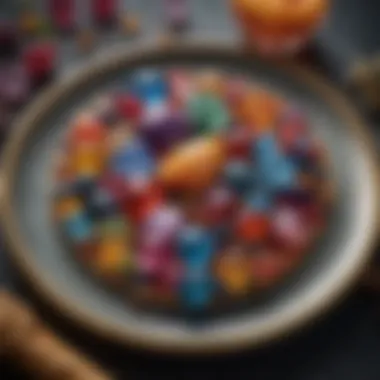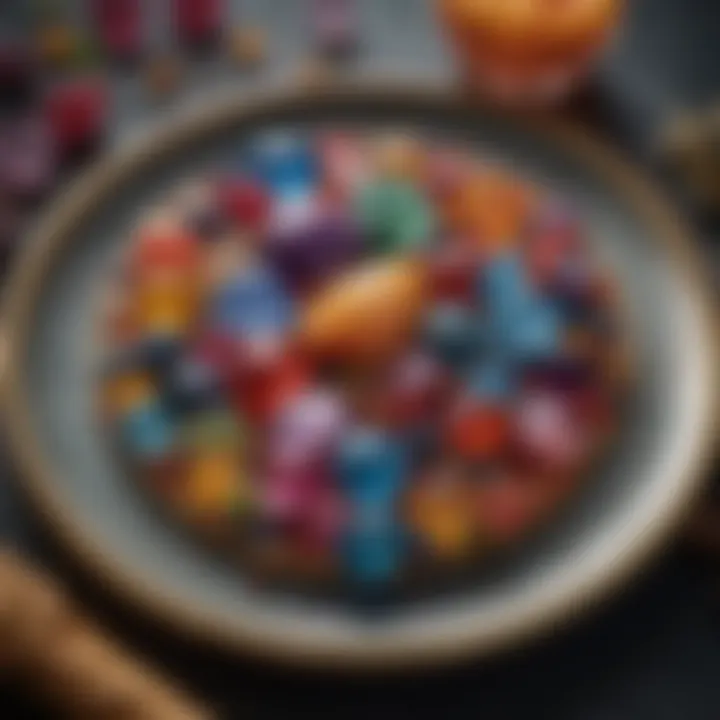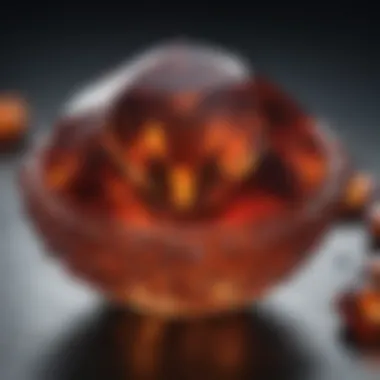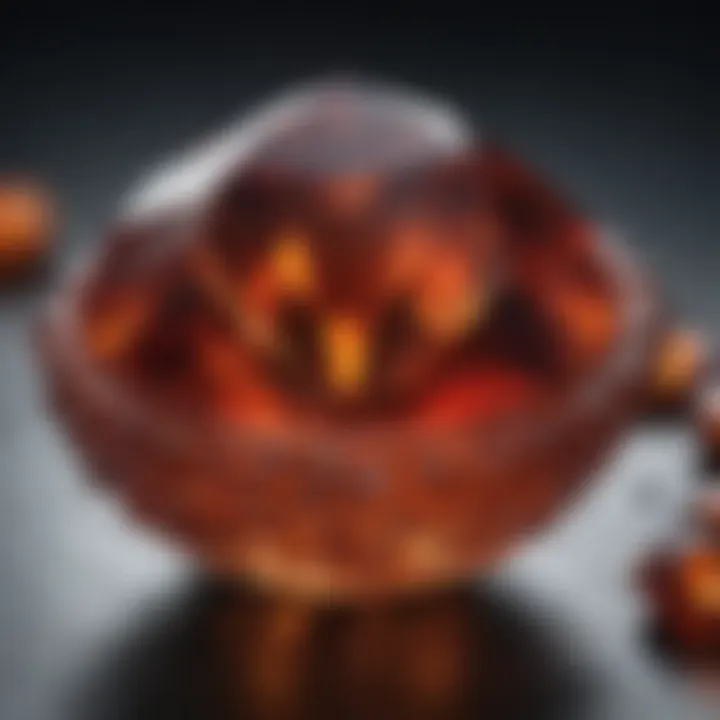Exploring Edible Gemstones in Modern Cuisine


Intro
The culinary world is constantly evolving, and it seems the boundaries of what we can consume are only expanding. Within this vibrant atmosphere, edible gemstones are emerging, sparkling in the realm of gastronomy. This unusual phenomenon marries the elegance of precious stones with the delights of our palate. It might seem a bit eccentric at first, but delve deeper and you'll find a treasure trove of flavor and nuance.
Gemstone Overview
Definition and Origins
Edible gemstones are, as the name implies, consumable creations that mimic the appearance and allure of naturally occurring gemstones. These aren't just colorful decorations; they are crafted from food-safe materials, designed to both dazzle and delight the senses.
The origins of these culinary gems can be traced back to ancient practices where the art of gastronomy and craftsmanship intersected. Culinary artisans began to experiment with ingredients, looking to replicate the visual splendor of gemstones using jelly or sugar. Over the years, this art has blossomed into a fascinating niche, becoming increasingly popular in modern dining experiences.
Historical Significance
Historically, the presentation of food, much like the adornment of oneself with jewelry, has held considerable social value. In ancient cultures, lavish displays of food were often seen at banquets, signifying wealth and power. Edible gemstones serve as a contemporary extension of this tradition. They evoke a sense of grandeur reminiscent of royal feasts from centuries past, where one would find intricate sugar art gracing the tables.
"The elegance of edible gemstones lies not just in their appearance but in the stories they tell of craftsmanship and tradition."
From their early days, these gems were an occasional novelty. Today, however, they are being integrated into menus across the globe, used to elevate dining experiences from ordinary to extraordinary.
Gemstone Properties
Hardness and Durability
In the world of real gemstones, hardness and durability are paramount. However, when we talk about their edible counterparts, these properties transform into texture and consistency. Edible gemstones often prioritize softness while maintaining a substantial bite. This ensures that they can be enjoyed without compromising the overall mouthfeel of the dish.
Color and Clarity
The allure of gemstones lies significantly in their color and clarity. Edible gemstones are crafted to reflect a spectrum of vibrant hues, shimmering under lights, drawing the eye and capturing attention. Their clarity is derived from the careful selection of ingredients that provide both a translucent visual appeal and a delightful taste.
In essence, the construction of these culinary gems is a delicate dance of color selection, ingredient combination, and artistic presentation. This meticulous crafting process is essential for not just aesthetics but also the overall gastronomic experience.
As the trend of edible gemstones takes root, it invites a curious blend of art and flavor, encouraging both chefs and diners to embark on an adventurous culinary journey.
Prelude to Edible Gemstones
The culinary landscape is undergoing a remarkable metamorphosis, spurred by innovative techniques and artistic expressions in gastronomy. One of the latest phenomena capturing the attention of chefs and food enthusiasts alike is the emergence of edible gemstones. These delightful creations transcend traditional food presentation, transforming dishes into edible art that tantalizes not just the taste buds, but the visual senses too.
At first glance, edible gemstones might appear to be nothing more than a novelty item. However, their significance extends far beyond surface-level appeal. They challenge the notion of how we interact with food, urging consumers to reconsider its aesthetic value while also exploring unique flavors and textures. When thoughtfully incorporated into dishes, edible gemstones can elevate mundane meals into extraordinary experiences.
The charm of these culinary gems lies in their ability to bridge cultures, cuisines, and experiences. They encapsulate a rich tapestry of history while presenting opportunities for modern innovation and creativity in the kitchen. A deeper examination of this topic is essential to appreciate the groundswell of enthusiasm surrounding edible gemstones, their rich historical context, and the profound impact they may have on the future landscape of fine dining.
Defining Edible Gemstones
In essence, edible gemstones are crafted food items that closely mimic the appearance of precious stones, using a variety of techniques and ingredients. These creations can range from sugar-based confections to gelatinous forms infused with flavors and colors that mirror the look of sparkling jewels. The goal is simple yet ambitious: to produce a visual spectacle that delights the eye and entices the palate.
The process of making edible gemstones can vary widely, encompassing traditional culinary arts like candy-making, as well as more modern techniques borrowed from molecular gastronomy. The base ingredients often include sugar, agar-agar, and various flavoring agents. Artists and chefs utilize these components to create textures and effects that replicate the crystallinity of gemstones, allowing diners to explore vibrant, jewel-toned colors and striking shapes.
The appeal of these gemstones isn't limited to just their appearance; they can also introduce unexpected flavors. For example, a sapphire-colored edible stone might burst with a tart berry essence, while a ruby variant could offer a rich pomegranate taste. This duality of engaging the senses makes edible gemstones a marvel in contemporary cuisine, inviting both playfulness and sophistication onto the plate.
Historical Context of Edible Gemstone Use in Cuisine
The history of edible gemstones can be traced back centuries, with roots that delve into the cuisine of several cultures. In the past, foods that mirrored precious items were often reserved for special occasions, symbolizing wealth and luxury. For instance, decorative confections, often created for royalty and elite gatherings, were fashioned to resemble valuable gems and served as a sign of opulence.
As we dig deeper, it's clear that various cultures have utilized elements resembling gemstones throughout culinary history:
- Middle Ages: In medieval Europe, intricate marzipan sculptures mimicked pearls and rubies, being centerpieces for feasts among nobility.
- Asia: In traditional Chinese celebrations, festive sweets often featured bright, gemstone-like colors and designs to symbolize good fortune.
- Modern Era: In recent times, the rise of molecular gastronomy has opened new doors for chefs, allowing them to experiment with forms and presentations that evoke the elegance of gems.
With each generation, these practices adapted and evolved, paving the way for the contemporary approach to edible gemstones. The merging of artistry and food continues to forge connections, enhancing both celebration and culinary exploration.


"Food not only brings people together but it also tells a story, a reflection of culture and creativity. Edible gemstones resonate with this idea, beckoning us to appreciate food in new and exciting ways."
In summary, the fascinating world of edible gemstones is imbued with historical richness that amplifies their modern-day resonance in the culinary arts. As we explore these stunning creations further, we'll uncover their applications, cultural significance, and the potential impact they hold within the gastronomy of tomorrow.
Culinary Applications of Edible Gemstones
Culinary applications of edible gemstones represent a burgeoning frontier in modern gastronomy. The mere sight of exquisite, jewel-like delicacies elevates the dining experience, turning an ordinary meal into an extraordinary feast for the senses. This section elucidates the various ways edible gemstones are being incorporated into food, showcasing their versatility and the myriad benefits they bring to culinary art.
Prelims in Desserts and Pastries
Desserts and pastries have always been the playground for creativity in the culinary world. With the integration of edible gemstones, chefs are stepping up their game to create visually stunning confections. Think about a rich chocolate torte gracefully adorned with shimmering sugar pearls that might resemble sapphires or rubies. Such presentations merge beauty with taste, delighting patrons with both visual and gustatory pleasure.
For instance, one can infuse cakes with flavors inspired by the hues of various gemstones. A lemon tart decorated with vibrant edible garnets could tantalize your taste buds while simulating the aesthetic appeal of nature’s treasures. Not only do these gems bring a sensory experience, but they also create a sense of luxury and extravagance. Moreover, they allow for a little playfulness in presenting desserts that mimic the beauty of traditional jewelry. It opens the door for chefs to tell a story through sweet creations, making each bite a journey into a world where culinary artand precious gemstones intertwine.
Incorporation in Savory Dishes
It's not just sweets that benefit from edible gemstones; savory dishes have also embraced these dazzling elements. Imagine a beautifully plated dish of roasted vegetables topped with glimmering edible crystals. The gems can add an unexpected crunch and a rich, subtle flavor that enhances the overall palate of the dish. The appeal lies not only in their taste but also in their striking appearance that captivates diners from the first moment they lay eyes on the meal.
Some culinary adventurers are experimenting with gemstone-infused oils or sauces. Take, for example, a garlic-infused olive oil with flecks of ground gemstones. This could serve as a finish for grilled meats or as a dip for artisan bread, weaving rich flavor with the elegance of gemstone aesthetics. Creativity in pairing gemstones with complementary flavors is expanding the boundaries of traditional cooking, encouraging chefs to explore unique combinations that couldn’t be possible otherwise.
Crafting Edible Gemstone Beverages
The journey into the world of edible gemstones isn't confined to solid food alone; beverages, too, are entering a new realm of innovation. Crafting cocktails and mocktails infused with edible gemstones can turn a simple drink into a spectacle. Picture a sparkling prosecco cocktail embellished with edible diamond-like sugar crystals slowly melting into the drink, releasing a hint of sweetness as you sip.
Moreover, gemstone-infused teas or juices are becoming popular as well. These beverages bring both visual allure and a whisper of unique flavor blended nicely with natural ingredients. One could envision a lavender-infused tea served with delicate, sparkling gemstones floating gracefully atop, providing not just refreshment but also a feast for the eyes and spirit.
"Edible gemstones are more than just a trend; they encapsulate a blend of art, nature, and flavors that redefine culinary experiences."
The exploration of these edible beauties pushes the boundaries of culinary creativity. As more chefs tap into this imaginative approach, the dining landscape may never be the same again. Readers intrigued by this frontier of gastronomy should keep an eye on the evolving trends, as edible gemstones may soon just become a staple, not a rarity.
Nutritional Aspects of Edible Gemstones
Delving into the nutritional realm of edible gemstones offers a fascinating perspective that goes beyond mere aesthetics. While the visual appeal of these culinary jewels captures attention, understanding their nutritional aspects is equally important for discerning customers and chefs alike. Culinary trends today emphasize not just taste and appearance, but also health benefits. Therefore, exploring how edible gemstones contribute to nutrition opens the door to a more holistic view of gastronomy.
Health Benefits and Nutritional Value
When discussing the nutrition behind edible gemstones, it’s essential to highlight that, despite their fanciful appearance, many of these gems harbor genuine health benefits. For instance, certain gemstones are infused with minerals and trace elements beneficial to human health. Depending on the specific stone used, the nutrients may enhance digestion, improve skin health, or even bolster the immune system.
- Crystals like Amethyst may be praised for their calming effects, potentially aiding in stress reduction, which can indirectly support overall health.
- Lapis Lazuli, often considered a decorative gem, is infused with cornflower blue hues and is believed to provide a boost in vitality due to its purported rich iron content.
- Gold and Silver Leaf, while not technically gemstones, are often elegantly layered onto desserts and dishes, providing not only a dazzling look but also antioxidant properties.
However, it is crucial to approach these claims with caution. Health benefits stemming from edible gemstones often lack extensive scientific backing, and while they can indeed add a unique flair to culinary creations, their true nutritional impact might be exaggerated in some contexts. Moreover, the preparation methods play a significant role in retaining these possible benefits. If not processed or incorporated correctly, their nutritional potential might be lost.
Evaluating Safety Standards and Regulations
As with any food product, safety standards are paramount when it comes to the use of edible gemstones in cuisine. Regulatory bodies, such as the Food and Drug Administration (FDA) in the United States, impose strict guidelines on food items to ensure they do not pose any health risks. These regulations often extend to what can be labeled as "edible" and what is merely decorative.
The inclusion of edible gemstones in food items brings about some common considerations:
- Source of Materials: Ensuring that the gemstones are sourced from reputable manufacturers who adhere to safety protocols is vital.
- Compliance and Testing: Regular testing for contaminants and toxic substances must be observed to prevent any health hazards.
- Transparency in Ingredients: Listings should be clear about the origins and safety assurances related to the gemstones used in food.
"Safety comes first; an edible gemstone should be as safe as it is stunningly beautiful to eat."
In summary, while edible gemstones can provide some intriguing health benefits, careful consideration must be given to their nutritional value and compliance with safety regulations. Chefs and consumers need to remain informed to make educated choices while navigating this captivating new frontier in gastronomy.
Cultural Significance and Symbolism
Exploring edible gemstones uncovers not just attractive appearances but also rich cultural connections. These gems have roots that stretch back through various societies, often interlaced with spirituality, tradition, and art. The importance of understanding the symbolism and cultural contexts tied to these edible jewels enhances our appreciation of their place in modern gastronomy.
Role of Gemstones in Various Cultures
Gemstones have always held significant meanings across cultures. Take for instance, the deep blue sapphire, a stone that has symbolized wisdom and virtue in many Asian cultures. Edible variations of such gemstones often reflect not just their aesthetic charm but also their intended effect on the consumer's experience.


- In ancient Egypt, culinary elements shaped like precious stones were believed to reflect the divine. Foods ornamented with edible jewels communicated power and opulence, elevating meals into feasts of grandeur.
- In Persian traditions, the use of gems in desserts not only delighted the palate but also embedded a sense of serenity and peace.
Moreover, various cultures attribute different properties to their gemstone-inspired foods. For example, the quartz families like rose quartz are often linked with love and harmony, which can be reflected in dishes aimed at romantic gatherings. Such meanings might heighten the dining experience or stir emotions tied to the cultural heritage behind the dish.
"Cooking with gemstones is not simply about taste or beauty, but celebrating history through the table."
Culinary Uses in Traditional and Modern Contexts
The culinary landscape for edible gemstones ranges from traditional uses to modern innovations. Historically, certain cultures have incorporated colored sugars or edible glitter resembling gems into their delicacies. In modern gastronomy, chefs now use sophisticated techniques to reproduce the visuals of gemstones with a playful twist on textures and tastes.
- Traditional Uses:
- Modern Interpretations:
- In some parts of India, sweets are decorated with shimmering edible gold and silver leaves, mimicking the allure of precious stones.
- Middle Eastern baklava sometimes includes jewel-like pieces of pistachios or pomegranate seeds, making them not only visually stunning but also culturally significant.
- Innovative chefs are now pushing boundaries, experimenting with algae-based gem-like jellies and fruit crystallizations that are visually stunning.
- Restaurants are crafting entire tasting menus where each dish is inspired by a gemstone’s properties, elevating the dining experience into a journey through color and flavor.
Understanding these uses fosters a deeper connection between the food, the culture, and the experience of dining with edible gemstones. The balance between older traditions and contemporary culinary techniques creates captivating narratives around these dishes, encouraging diners to engage not just with their taste buds but also with stories that enrich the experience.
Crafting Edible Gemstones
Crafting edible gemstones is not merely a culinary endeavor; it is an art form that beautifully merges creativity with gastronomy. This section delves into the intricate process of creating these visually stunning and delicious treats. The importance of this topic lies in understanding how edible gemstones can elevate any dining experience through their uniqueness and visual appeal.
Ingredients and Techniques Used
Creating edible gemstones involves a variety of ingredients that are both natural and safe for consumption. The base often includes sugar, gelatin, and natural colorants derived from fruits, vegetables, and spices. For instance, beet juice can contribute a vibrant red hue, while spirulina yields a beautiful blue. The meticulous selection of these ingredients plays an essential role in achieving not only aesthetics but also flavor complexity.
The techniques employed in crafting these gemstones are both precise and innovative. Traditional candy-making processes are often adapted, but modern culinary techniques also come into play. Here are some critical methods used:
- Molding: Silicone molds with intricate designs are commonly used to shape the gemstones. The individual molds can be customized to represent different gemstone styles such as sapphires, rubies, or emeralds. This step adds an artistic dimension to the process, allowing for creativity in presentation.
- Crystalization: This method gives the gemstones their shiny, reflective surfaces. By allowing the mixture to set in a controlled environment, chefs can create a crystalline appearance that mimics real stones. It's almost like watching magic unfold in the kitchen.
- Painting & Finishing: To enhance the visual appeal, a light dusting of edible glitter or a brush of metallic luster can be added. These finishing touches serve to elevate the sweet treat to something approaching sculpture.
The blend of these ingredients with the right techniques can yield a variety of flavors, from fruity to floral, making them not merely a feast for the eyes but also a delight for the palate.
The Role of Culinary Artists in Creation
Culinary artists play a vital part in the process of crafting edible gemstones. Their training in the culinary arts, along with their artistic intuition, allows them to envision and execute designs that captivate an audience. They are not only chefs but also sculptors, utilizing their skills to carve out a niche within the culinary world.
Collaboration among the team, which might include pastry chefs, chocolatiers, and even food scientists, adds layers of complexity to the creation process. Their combined expertise ensures that every gemstone is not just visually appealing but also safe and delightful to eat.
"In the realm of edible masterpieces, culinary artists are like jewelers crafting exquisite pieces that glimmer with both taste and aesthetic."
In addition, they experiment continuously, pushing the boundaries on flavor profiles and presentation. This experimental journey is paramount—it leads to the refinement of techniques and ingredients which contribute to the overall evolution of edible gemstones in modern gastronomy.
Ultimately, crafting edible gemstones emerges as a fascinating exploration of flavor, art, and innovation. As these culinary artists continue to push the envelope, one can only wonder what future creations will sparkle on our plates.
Market Trends and Consumer Interest
The world of gastronomy is ever-evolving, and as new trends emerge, they often spark the imaginations of chefs and food enthusiasts alike. Market trends and consumer interest in edible gemstones signify not just a passing fancy; they indicate a growing appreciation for artistic culinary expressions that invite innovation and creativity. This section delves into the nuances of these trends while highlighting the factors driving consumer curiosity and the industry’s response.
Emerging Trends in the Culinary World
In recent years, chefs and culinary artists have begun to push the envelope with the introduction of edible gemstones into main menus and exclusive dining experiences. Some emerging trends include:
- Instagrammable Desserts: The rise of social media has paved the way for visually stunning dishes that are not just delicious but also aesthetically pleasing. Edible gemstones, with their colors and sparkle, lend themselves beautifully to this trend, prompting diners to capture and share their edible art.
- Culinary Jewel Boxes: Restaurants are experimenting with themed tasting menus that include dishes crafted to mimic or incorporate edible gemstones. These experiences cater to diners seeking something extraordinary and out of the ordinary.
- Sustainable Sourcing: Nowadays, many consumers are expressing preferences for products that are sustainably sourced. Culinary artisans are responding by ensuring that their edible gemstones, whether made from natural ingredients or innovative synthetic methods, align with eco-friendly practices.
By embracing these patterns, establishments can create a unique niche that appeals to a variety of consumer palates, thus fostering a dedicated following.
Consumer Response and Market Growth
As word spreads and curiosity about edible gemstones grows, the market reflects this enthusiasm. Notably, consumer responses seem to converge on a few key insights:


- Curiosity and Experimentation: Many diners are excited to try new things. The intrigue around edible gemstones brings a sense of adventure to the table, pushing people out of their comfort zones.
- Premium Pricing: Given their unique appeal, restaurants can charge a premium for dishes featuring edible gemstones. Diners seem willing to pay for this experience, understanding that it’s not just a meal but a carefully crafted artistic expression.
- Increased Demand for Novelty: With a saturated market, consumers are hunting for experiences that stand apart. Edible gemstones offer that element of novelty, setting restaurants apart in a crowded marketplace.
"The vibrant colors and allure of edible gemstones charm both the eye and the taste buds—it’s as if you’re consuming a piece of art!"
As consumers continue to express interest in novel culinary experiences, it’s clear that the popularity of edible gemstones will only burgeon. The intersection of art and gastronomy is a fertile ground for innovation, and the future looks bright for those venturing into this scintillating new frontier.
Challenges and Criticisms
Exploring the landscape of edible gemstones isn’t all sparkles and delight. The growing interest in these culinary marvels has opened up discussions surrounding their challenges and criticisms. Delving into this topic helps illuminate the fine intricacies and potential pitfalls of incorporating such enchanting elements into dining experiences. One major consideration here is consumer skepticism towards the actual utility and value of these edible gems. Some may question whether they truly enhance culinary creations or if they simply serve as a gimmick to lure trendy diners.
A significant part of these criticisms stems from misconceptions surrounding edible gemstones. As innovative as they may seem, many individuals still associate the term "gemstone" exclusively with lavish jewelry and ornamental beauty. The notion of eating something typically deemed precious and decorative can trigger confusion and even disappointment amongst some potential consumers. Beyond aesthetics, surely there's more to consider.
Addressing Misconceptions and Misunderstandings
Understanding edible gemstones goes beyond their sumptuous appearance. While the visual appeal is undeniable, it’s crucial to clarify the materials that make up these delicacies. It’s essential to communicate that although they share the name "gemstone," the substances used in creating edible gemstones differ from traditional, non-edible gems. For instance, some gemstones are derived from natural, food-grade sources like sugar, agar, or gelatin, designed explicitly for consumption.
To further tackle misconceptions, culinary experts must work tirelessly to educate the public around the properties and flavors associated with these unique culinary constructs. Consumers should know that these edible gems can consist of various flavors, ranging from fruity bursts to rich chocolate notes. With proper education, it could help dismantle false beliefs and encourage a broader acceptance of edible gemstones within the gastronomical community.
"The true beauty of edible gemstones lies not only in their dazzling appearance but also in their ability to transform traditional dishes into extraordinary experiences."
Navigating the Fine Line Between Innovation and Gimmick
As trends rise and fall with the tides of culinary creativity, striking a balance between innovation and genuine value is crucial. Edible gemstones sit right at this crossroads. Some chefs and culinary artists skillfully integrate these gemstones to elevate their dishes in a way that feels authentic, while others risk falling into the trap of appearing frivolous.
To avoid being labeled as a mere gimmick, it's essential for culinary professionals to focus on both creativity and taste within their edible gem creations. This involves not just using colorful, glittery stones but ensuring that they add a meaningful dimension to the dish's overall narrative. Each gemstone should complement flavors and textures, enhancing the dining experience rather than overshadowing it.
Additionally, the conversation surrounding sustainability comes into play. Are the methods of creating these edible stones environmentally conscious? As a growing number of consumers prioritize ethical dining experiences, those in the culinary world should tread carefully along this fine line between captivating novelty and responsible innovation.
Ultimately, embracing the art of edible gemstones within gastronomy demands a thoughtful approach, blending beauty with substance, and, most importantly, a clear understanding of their role within the broader context of culinary creativity.
Future of Edible Gemstones in Gastronomy
The future of edible gemstones in gastronomy holds a myriad of promising possibilities that reach beyond the dinner plate. As culinary innovation surges, these sparkling treats are transforming how chefs and consumers perceive food. It raises questions about not just how dishes taste, but how they look and feel too. The infusion of gemstones into cuisine offers an exciting avenue for creativity and experimentation, bridging the gap between art and gastronomy.
Potential for New Culinary Innovations
The growing traction in the use of edible gemstones opens doors to a plethora of culinary innovations. Chefs, inspired by the aesthetic allure of these gemstones, might blend traditional cooking with cutting-edge techniques. Think of crystal-like desserts that shimmer under the dining room lights, capturing the imagination of the patrons. This kind of artistry serves to enhance the dining experience significantly.
Culinary artists might experiment, adapting not just taste but texture, making use of the unique properties of different ingredients. Sugar, for example, can be manipulated into shapes that mimic natural gemstones, while flavors can be infused to surprise and delight. Additionally, chefs can explore novel flavor pairings that complement the gemstones’ inherent qualities, stretching the limits of palatability.
Moreover, as sustainability becomes a significant factor in the food world, there's potential for edible gemstones made from local or organic ingredients to emerge. This could not only entice the eco-conscious dining crowd but also inject regional flavors into a burgeoning trend.
"Innovation in cuisine is about pushing boundaries while respecting traditions. Edible gemstones are a perfect example of this blend."
Impact on Dining Experiences and Consumer Expectations
With the incorporation of edible gemstones, dining experiences are set for a notable transformation. Consumers increasingly seek not just a meal, but an experience. They want their food to look as good as it tastes. When gemstones are introduced, they become conversation starters—more than just food, they signify artistry and imagination.
Furthermore, social media plays a role in defining consumer expectations in this regard. Dishes that pop with color and appear extraordinary have a higher likelihood of being shared online, making restaurants more inclined to cater to visually stunning presentations. Dining establishments that embrace the gem trend may find themselves featured prominently on platforms like Instagram and Facebook, bringing in curious patrons eager to see these culinary masterpieces in person.
This trend also encourages chefs to rethink their menus frequently, allowing for seasonal offerings that align with gemstone aesthetics. Ultimately, consumers will become more adventurous, eagerly anticipating the next culinary marvel that shines and sparkles.
In summary, the future of edible gemstones is not only about delightful flavors but encompasses innovation, sustainability, and a shift in how we perceive dining. With these sparkling gems, the culinary world stands on the brink of a transformation, where beauty and taste merge in unprecedented ways.
The End
Reaching the end of this exploration into edible gemstones, it's clear that these unique culinary innovations hold a distinctive position within modern gastronomy. As we've journeyed through the rich layers of history, cultural significance, and nutritional benefits, one fundamental truth emerges: edible gemstones are more than just aesthetic additions to our plates; they're transformative agents in the culinary landscape.
Summary of Edible Gemstones' Significance
Edible gemstones signify a merging of beauty and taste that challenges traditional notions of food. By allowing chefs to express creativity through flavor and appearance, they bridge a gap between art and cuisine. Their ability to add visual splendor and unconventional flavors enhances not only dishes themselves but also the overall dining experience. In a world where food presentation increasingly matters, gemstones add a sprinkle of luxurious indulgence. They also exemplify sustainability, often crafted from natural plant-based ingredients, which aligns well with evolving consumer preferences toward health-conscious, eco-friendly choices.
Encouragement for Exploration and Innovation
The potential of edible gemstones within gastronomy is just beginning to unfold. As culinary trends shift, embracing new techniques and ingredients will be paramount for chefs and enthusiasts alike. Now, more than ever, there is a call to push the boundaries of traditional cooking. Experimenting with gemstone flavors can lead to exciting discoveries, whether it's a sea-salt infused sapphire-inspired gel or a delectable ruby chili-infused glaze. The doors to exploration are wide open, encouraging culinary artists to venture into uncharted territory. This pursuit not only fuels innovation, but also invites conversations about food, art, and culture.
Edible gemstones are not just about eating; they're about experiencing beauty, creativity, and flavors that can elevate every bite.



